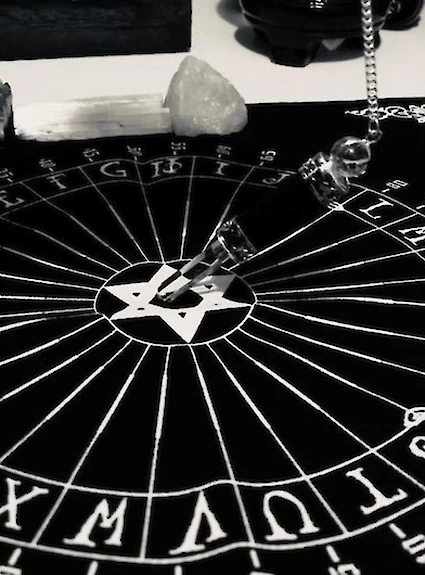

The Ideomotor Phenomenon
Items like pendulums and Ouija Boards are quite popular with paranormal investigators as they believe it provides a way to channel information from the other side using yourself as a conduit. There is however a debate within the paranormal community as to whether this information is coming from a spirit, some sort of supernatural force, or if it is just tapping into our own subconscious causing an involuntary muscle movement. This involuntary muscle movement is called the ideomotor phenomenon. On a conscious level, you are not aware of doing anything, however, on an unconscious level, your body could be making involuntary movements that you are not aware of.
This term was originally coined by William B. Carpenter in 1852. He used this as an explanation for the movement of dowsing rods, pendulums, sticks, or even a planchette on an Ouija board. He wasn’t at all claiming that people were being deliberately deceptive, but they were completely unaware that their slight muscle movements were causing these items to move. One of the examples he commonly used was that of dowsing rods. When using dowsing rods to track water, if you were to tell someone who hasn’t used the rods before that there is water at a certain point in the ground, when they reach it, their rods will cross. They aren’t doing this deliberately. It is because subconsciously they know where the water is so their subconscious is controlling the muscle movement.
Ideomotor in telepathy experiments
Psychical researchers and parapsychologists in the past would test certain claims of psychical ability. This included things like thought transference and telepathy. In 1877 W.F Barrett with his friend who was a famous surgeon at the time tested claims of thought transference via touch. The subject who was the person they were experimenting with left the room so he could not see nor hear Barrett and his surgeon friend Mr. Lawson Tait. Barrett and Mr. Tait decided that the subject should be influenced telepathically to move the fire screen and double it back when he came back into the room. Mr. Tait proceeded to put his arms around the waist of the subject and mentally willed the subject to perform this action. At first, the subject seemed like he didn't know what to do until he spontaneously went and did exactly what Mr. Tait willed him mentally to do. There were many further instances where Barrett talks about his subjects performing the tasks they were mentally willed to do without any sort of noticeable physical or verbal cue (which had been witnessed with public thought transference performers).
One of the explanations given other than what seemed like genuine acts of telepathy was that the subjects were led by involuntarily muscle movements given by the person 'willing' them to perform an act ...
consciously or unconsciously , the indications involuntarily and unwittingly supplied to him by the muscles of the subject
Backing up this theory was the fact that when subjects were asked to verbally communicate what it is that they were willed to do, they couldn't seem to answer the question as consciously they really had no idea what they were supposed to do. They could not verbalize it however when they were asked to just go and do what they felt like they had to do, there was a high success rate. It suggested that the information was either received telepathically or the person was guided with muscle movement with both occurring on an unconscious level.
You can read more about this particular experiment in my article: Thought Transference
Other telepathy experiments such as J B Rhine's famous Zener Cards trials were often criticized as testers could cue the subject taking the test on an involuntary level to lead them to guess the correct card. With this in mind, telepathy experiment controls evolved and when you look at experiments such as the Ganzfeld experiment, the subject was blindfolded which provided a double bonus. It not only induced sensory deprivation which was the main intention, but it also meant a person could not be guided by involuntary visual cues caused by the ideomotor phenomenon.
Divination, Ideomotor and paranormal investigating
Divination is an ancient art with the purpose to seek knowledge or predict the future through what is thought to be using supernatural methods. Think of things like Scrying or using a pendulum for example. In modern-day paranormal investigation, the concept of divination in a lot of ways has become 'electronic' with people now using devices to give the yes/no answers that things like dowsing rods or pendulums once provided. I have to wonder if this practice in some way has influenced the way that people interpret the faces they see in mist or even 'orbs'. While we know that pareidolia causes our brain to 'fill in the blanks' and make us see these faces etc, the concept of divination would argue that you are seeing what your brain thinks you are supposed to see. While I may not necessarily agree with that statement, the fact remains that people are constantly looking for these faces on all sorts of surfaces and particles and believe it is a spirit. Often this gives them a form of comfort or even validation.

Image by Sarah LLIFS
Divination in a lot of ways seems to have shifted from self-reflection or even foretelling the future through to spirit communication. Instead of divination being used as a tool for self-reflection, it is being used as a tool for spirit communication. Maybe this is where we are getting it wrong .... or maybe people are getting it right but we are looking at it wrong? A lot of the time, people comment that they see a face in an orb and feel it is a loved one. For them, it gives them comfort. Maybe they need that comfort and the brain is showing them what they need to see. It is quite likely that is why we don't see what they see as it really is a form of pareidolia, however this evokes emotion to the person. In reflection, it could be what that person needs at the time.
A study from 2017 suggests that our personality type may influence how prominent the ideomotor phenomenon influences the way we use things like a pendulum, making it even harder for us to decipher the results a person is claiming to receive.
For centuries, people have consulted hand-held pendulums in an attempt to aid decision-making. We examined which personality measures predicted performance when deciding about the presence of visual stimuli. Participants either responded verbally or by “asking” a pendulum and watching its motion after we paired particular movements with different answers.
Several personality measures predicted performance. In the verbal condition, people who felt more control over their lives (locus of control) performed better than those who felt less control. In the pendulum condition, people high in transliminality – those sensitive to subtle stimuli – performed better than those low in transliminality. Indeed, transliminality may capture some important aspects of pendulum use.
Olson JA, Jeyanesan E, Raz A. Ask the pendulum: personality predictors of ideomotor performance. Neurosci Conscious. 2017;2017(1):nix014. Published 2017 Aug 2. doi:10.1093/nc/nix014
The study seems to highlight the major problem that we face in determining the results people are receiving through these methods. There is really no way for us to tell if someone is receiving answers through paranormal means or if they are merely just accessing something on a subconscious level. As they say “Beauty is in the eye of the beholder”.. meaning that beauty doesn’t exist on its own but is created by its observers. Maybe this rings true in the eye of the seer performing divination. It is all down to how a person perceives the information.
Suggestion
It is important when looking at the ideomotor phenomenon to also consider that a person is being led or suggested to make these involuntary muscle movements. Some people believe that if you are doing things like table tipping or using an ouija board that if you feel the urge to move that you should just go with it as it could be a spirit guiding you. In these circumstances, we also have to consider that when you are sitting on an ouija board for example and you are holding your hands in the same position for a long time that your hand will become tired or even twitch. If you 'go with it' you are reacting to your body's natural reflex. When you are using items such as a pendulum, the slightest of movements can cause a pendulum to start swinging. It is very easy to then start connecting dots where there are none. People sometimes will ask what they call control questions that they can't possibly know the answer to as a way to work around this. We have to remember that straight away they have a 50% chance of getting the answer right when the response is either yes or no.
Genetic memory
Another theory to consider is that while we are accessing information from our subconscious that is causing these involuntary muscle movements, what exactly is in our subconscious? Do we hold the genetic memories of our ancestors that provide us with answers to questions that consciously we couldn't possibly know? When we think we are receiving an answer from a loved one who has passed away, is it because we have their genetic memory stored in our unconscious? Carl Jung referred to this as the collective unconscious.
My thesis, then, is as follows: In addition to our immediate consciousness, which is of a thoroughly personal nature and which we believe to be the only empirical psyche (even if we tack on the personal unconscious as an appendix), there exists a second psychic system of a collective, universal, and impersonal nature which is identical
in all individuals. This collective unconscious does not develop individually but is inherited. It consists of pre-existent forms, the archetypes, which can only become conscious secondarily and which give definite form to certain psychic contents.Carl Jung
The Concept of the Collective Unconscious
If we go with this theory, when we are communicating with what we believe is a spirit of a family member, are the answers we are receiving because we are indeed communicating with this spirit, or are we simply accessing the answers via our genetic memories? Can we psychically project these memories and create our own spirit?
The ideomotor phenomenon is both an explanation and a possibility depending on which angle you look at it. While it is an involuntary muscle movement controlled by our subconscious we do have to wonder, what information is in our subconscious? If we are accessing memories from our ancestors does that still make it paranormal or just a part of our memory? Is there a reason for everything or is it just a convenient coincidence? What do you think?
References:
http://www.bahaistudies.net/asma/The-Concept-of-the-Collective-Unconscious.pdf
Olson JA, Jeyanesan E, Raz A. Ask the pendulum: personality predictors of ideomotor performance. Neurosci Conscious. 2017;2017(1):nix014. Published 2017 Aug 2. doi:10.1093/nc/nix014
Psychical Research by W.F. Barrett, F.R.S. Professor of experimental physics in the Royal College of Science For Ireland, 1973-1910
https://psychology.wikia.org/wiki/Ideomotor_effect
If you enjoy LLIFS, consider buying me a book (otherwise known as buy me a coffee but I don't drink coffee and I LOVE books). Your donation helps to fund the LLIFS website so everyone can continue to access great paranormal content and resources for FREE!

Top pages with similar subjects
Don't forget to follow the Facebook page for regular updates
Join the mailing list to receive weekly updates of NEW articles. Never miss an article again!
Buy the latest and past issues Haunted Magazine
Check out the books written by LLIFS